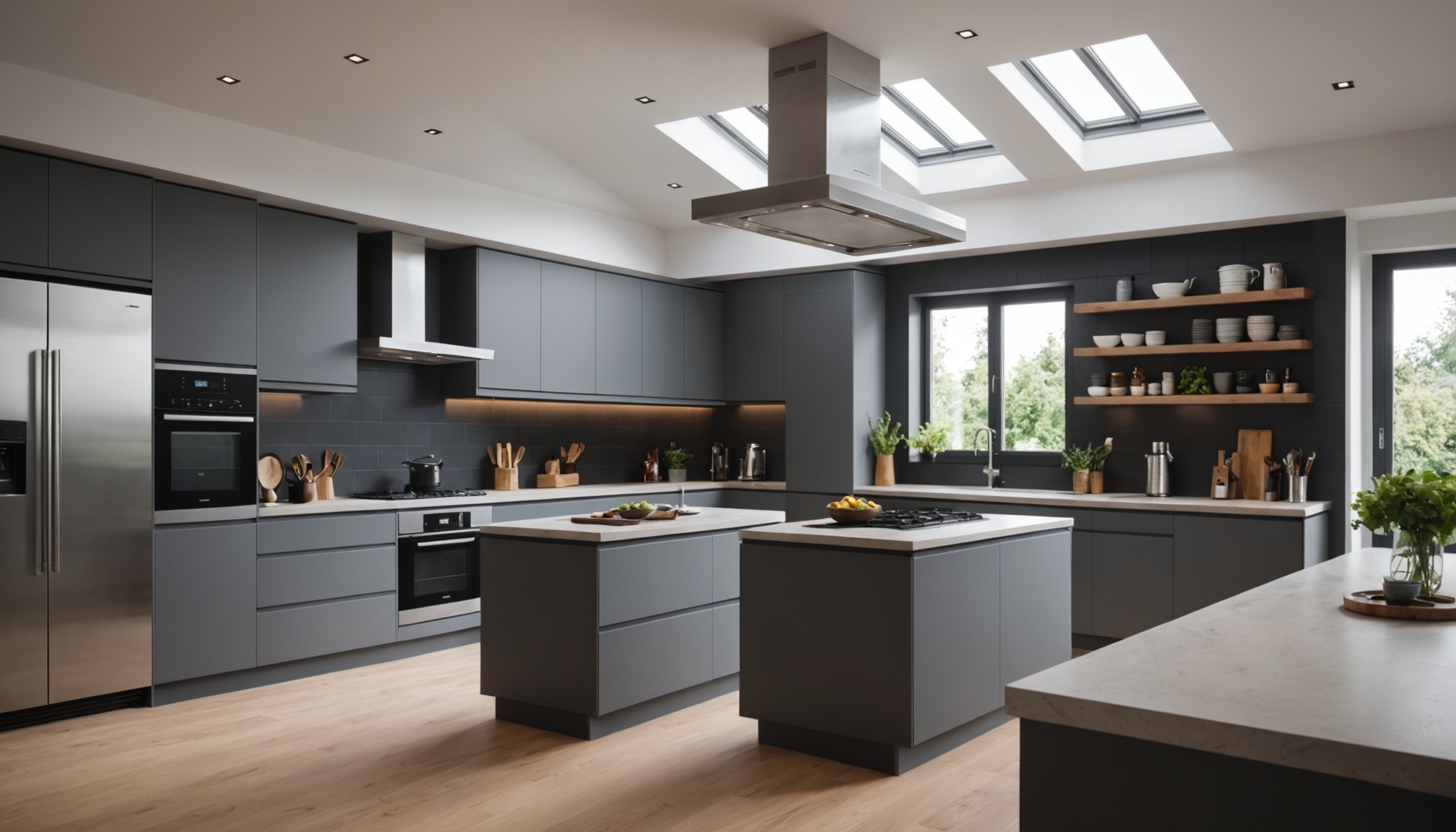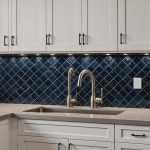Understanding Kitchen Ventilation Systems
Kitchen ventilation is crucial for maintaining a safe and comfortable cooking environment. Various kitchen ventilation types cater to different needs, from basic tasks to more intensive cooking activities.
Exhaust hoods are the most common, installed above the stovetop to remove cooking fumes directly from the source. They effectively minimize cooking odors, smoke, and excess moisture, contributing significantly to improved kitchen air quality. These hoods vent pollutants outside, making them highly efficient.
Topic to read : Designing a dreamy breakfast nook: chic inspirations for your ideal uk kitchen
Alternatively, downdraft systems pull smoke and steam downwards, away from the cooking area, and are particularly useful for kitchen islands where traditional hoods can’t be installed. While not as powerful as overhead systems, they are an innovative solution where space or design is a constraint.
Recirculating fans are another option, recirculating air through a filter that traps grease and neutralises odours. Although they do not vent outside, they are effective in areas where external venting is impractical.
Also read : Illuminate your stylish modern uk kitchen: a guide to selecting the ideal under-cabinet lighting
Highly effective kitchen ventilation keeps indoor air healthier and lessens accumulation of moisture, which can lead to mould and structural damage. It’s an essential consideration for preserving both the kitchen’s functionality and the occupants’ health.
Steps for Installing a Kitchen Ventilation System
When undertaking a DIY kitchen ventilation project, following a thorough step-by-step guide is crucial for a successful installation process.
Preparing for Installation
Begin by assessing your kitchen layout to determine the ideal location for your ventilation system. Consider factors such as proximity to cooking areas and existing power supply. Gather all necessary tools and materials—including screws, brackets, and duct tape—before starting the project. It’s essential to understand your venting options: direct venting through an exterior wall or recirculating models with filters.
Installing the Ventilation System
Once prepared, follow detailed step-by-step installation instructions for your specific model. Start by marking the vent’s placement and cutting the requisite space if needed. Secure the system properly using the provided hardware, ensuring all components are aligned and tightly fastened. Take note of safety precautions: wearing protective gear and turning off power sources is advisable. Check all connections to confirm there are no loose parts or wires, thus maintaining functionality.
Finalizing Installation
Finally, apply finishing touches such as sealing all seams with duct tape to prevent air leaks. Test the system by running it briefly to ensure effective operation. Conduct a cleaning and maintenance check to ensure all components are clean and functioning post-installation.
Comparing Ventilation Options
When considering ventilation systems, it’s essential to understand the differences between ducted and ductless systems. Each has distinct pros and cons. Ducted systems rely on a network of pipes to expel air externally. They are efficient in removing heat, moisture, and odours but can be costly and require significant installation, often influencing the structure of a building.
On the other hand, ductless systems are more versatile and easier to install, as they do not require extensive ductwork. They are ideal for smaller spaces or retrofitting but may not offer the same efficiency in filtering contaminants as ducted systems. Both styles can vary widely in price, influenced by factors such as brand reputation and system specifications.
When evaluating the cost of systems, ducted setups generally demand a higher initial investment due to installation complexities. In contrast, ductless models have lower upfront costs but may necessitate more frequent maintenance.
Ultimately, the choice between systems depends on specific needs, including kitchen size, budget, and personal preferences. Understanding these elements helps in making a well-informed decision, ensuring a balance between efficiency, aesthetics, and cost.
Maintenance Tips for Kitchen Ventilation Systems
When it comes to ensuring the longevity and efficiency of kitchen ventilation systems, maintenance practices are crucial. A key aspect is the regular cleaning and replacement of filters, essential for keeping the system running smoothly. Grease and grime can quickly accumulate, hindering airflow and causing potential mechanical problems. It is advisable to clean the filters at least every three months, though more frequent cleaning might be necessary depending on usage and cooking intensity.
Looking out for signs that your ventilation system might need repairs can save time and money in the long run. Some indicators include unusual noises, persistent odours, or decreased extraction efficiency. If you notice any of these, it may be time to consult with a qualified technician.
To enhance system longevity, follow these tips:
- Opt for high-quality, compatible replacement parts when necessary.
- Position your ventilation system appropriately, avoiding blockages.
- Consider professional inspection at least once a year to ensure optimal operation.
These maintenance practices not only improve kitchen air quality but also significantly extend the system’s lifespan. Taking proactive measures regularly will help maintain an efficient and trouble-free kitchen environment.
Legal Regulations and Requirements in the UK
Understanding UK kitchen regulations is crucial for proper installation and compliance. These regulations ensure safety and functionality in your kitchen environment. One of the primary concerns involves building regulations that dictate standards for kitchen ventilation. Adequate ventilation not only assures air quality but also helps in maintaining a comfortable cooking space.
Let’s address the common queries regarding necessary permits and inspections for installations. A kitchen installation often requires specific permits to ensure all work complies with health and safety standards. Once the work is completed, inspections might be necessary to verify that installations adhere to building codes and safety guidelines. It is advisable to consult with local authorities or professionals to clarify which permits apply to your project.
Compliance with UK standards can sometimes be daunting, but there are strategies to simplify the process. Hiring a certified installer familiar with installation guidelines is recommended to navigate these complexities. Their expertise can ensure that all installations meet specified standards, reducing the risk of future complications. Additionally, keeping abreast of updates to regulations can aid in maintaining compliance over time.
Frequently Asked Questions
In this section, we address some common kitchen ventilation FAQs, providing insights into optimal installation and troubleshooting for your systems.
Answers to Common Questions
Many homeowners wonder, “What size kitchen hood do I need?” A simple rule is to ensure your hood is at least as wide as your cooktop. This ensures effective capture of smoke and steam. For optimal ventilation effectiveness, match hood power (measured in CFM) to your cooking habits.
Troubleshooting Common Issues
Experiencing noisy operation post-installation? First, check for any blockages or bends in the ductwork. This might cause resistance, leading to increased noise. If your system isn’t removing odours effectively, ensure the filters are clean and that the fan speed is adequate for your cooking demands.
Best Practices for Enhancing Ventilation
Ensure regular maintenance of your system. Clean filters monthly, inspect ducts yearly, and always keep the cooking area clear for the best ventilation effectiveness. Install your system according to manufacturer instructions to avoid any common installation queries. A well-installed, maintained system will function efficiently, providing a safer, more comfortable kitchen environment.
Recommended Products and Resources
When seeking the best kitchen ventilation systems available in the UK, understanding what makes a product top-rated is crucial. Persuasive features often include energy efficiency, noise levels, and design integration. Consider the following highly recommended kitchen ventilation products:
- Cookology Curved Glass Hood: Known for its contemporary design and efficient suction power.
- Bosch DWK098G61: Offers sleek controls, energy efficiency, and is ideal for modern kitchens.
- Neff D90: Integrates well with smart home systems and offers whisper-quiet operation.
Beyond product selection, comprehensive resource links are essential for informed decision-making. Websites like Which? and Appliance Direct provide in-depth comparisons and customer reviews to help guide your purchase. Accessing these resources can highlight the unique features and specifications that suit your needs.
For installation and further assistance, consulting professional installers is wise. Platforms such as Checkatrade and Rated People can connect you with experienced professionals who ensure proper setup and optimal kitchen ventilation performance. By leveraging both reviews and expert guidance, you can confidently select a ventilation system that seamlessly meshes with your kitchen environment.











